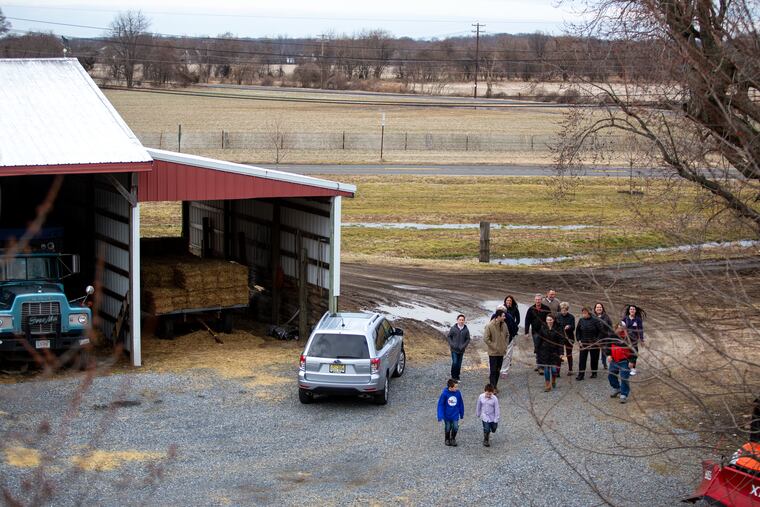Preserving the history of a South Jersey farm and family
“We can conjecture with some confidence that the house itself has been in our family at least since the Civil War, and perhaps since Revolutionary War,” current owner Scott Jones said. "The exact age of the farmhouse is part of that mystery. "

The sounds conveyed pure joy. Griffin Jones, 6, was tumbling down hay bales during a family gathering on his cousin’s farm in Lumberton, Burlington County. His big brothers, Cooper, 9, and Teddy, 10, cavorted nearby.
Not a single “tech toy” was in sight. Instead, the boys embraced nature, albeit with a farmhouse in view, and the chance to run free.
This historical 100-acre spread has created a way of life that some worry is disappearing from the American landscape.
“Once you live it, it lives in you,” said the boys’ great aunt, Irene Jones, who lived on the farm from 1954 to 2014 with her now late husband and sons. “I married into this life, and it’s been wonderful."
While Irene currently lives in a nearby senior community, she still spends many hours on the farm with extended family.
The memories also are embedded in her son, Scott. After his recent retirement from working as a professional forester and then as an investment executive in Boston, he decided to purchase the property, known as Linside Farm, from relatives.
"It's a decision I'm so glad I made," he said.
Jones is working on preserving and retaining the character of the farmhouse itself, even as he continues to trace the farm’s sometimes elusive history.
“We can conjecture with some confidence that the house itself has been in our family at least since the Civil War, and perhaps since the Revolutionary War,” Scott Jones said. “The exact age of the farmhouse is part of that mystery.”
He also has found documentation that Hessian soldiers marched through the farm, “but it is not certain that the house was actually there at that time.”
The farmhouse grew in stages, with an update of the third floor now under way. That was where the family newlyweds often lived. One of those original brides, Scott’s grandmother, was spunky enough even in old age to climb the outdoor steps to the top floor in all kinds of weather.
The first floor maintains its original plan with three large rooms: a kitchen; the “parlor,” now called the living room, and a dining room. The rooms are filled with family art from generations past and photos chronicling family life and events.
The family’s long and proud Quaker heritage is encapsulated in a collection of carefully preserved Quaker bonnets. There’s also an infant dress that’s been handed down through the years.
Older family members recalled funerals in the home, usually in the parlor. And during World War II, they remembered, a button was installed in the dining room to alert neighbors in nearby farms of air raids. Luckily, no attack ever came.
Gina Jones, mother of the three sons jumping around the hay bales, lives with her family on a neighboring farm. Her husband, Craig, is Scott’s cousin.
“I didn’t grow up on a farm, but my husband did,” Gina said, “and his dad and mother still do some light farming. But what is so wonderful to me is that your sons see their grandparents all the time and share this way of life with them.”
Irene Jones recalls a number of changes over time. A water heater replaced the stove for heating and women in the family stopped washing their hair in rainwater. By the 1950s, hand milking into buckets was replaced by line systems allowing the milk to go from the cows to stainless steel holding tanks. And by the mid-20th century, freezing fruit and vegetables became popular. The farm got its first freezer through luck in a charity raffle.
Gone now are the apple and pear orchards, along with a rhubarb garden, the old-timers said. Ditto an ice house and a barn built with hand-hewn beams.
For Scott Jones, the farm is about more than equipment and function. It’s truly defined, he said, by its present and future as a family gathering place where his wife and young adult children will celebrate milestones, carry on rituals, and create new ones.
The third-floor renovations aim to respect the farm’s roots while adding comfort and convenience. “But the character we want to preserve also is key,” he said.
Perhaps those antique Quaker bonnets and the landmark silo stand as metaphors for what was, and what still is, part of a respected and cherished heritage.
Even 6-year-old Griffin seems to sense that. “This is a cool place!" he said, emphasizing the word cool.
“It’s never boring here," he said, "and sometimes we go on fun tractor rides.”
Last seen, that’s what he was heading off to do.
Is your house a Haven? Nominate your home by email (and send some digital photographs) at properties@phillynews.com.